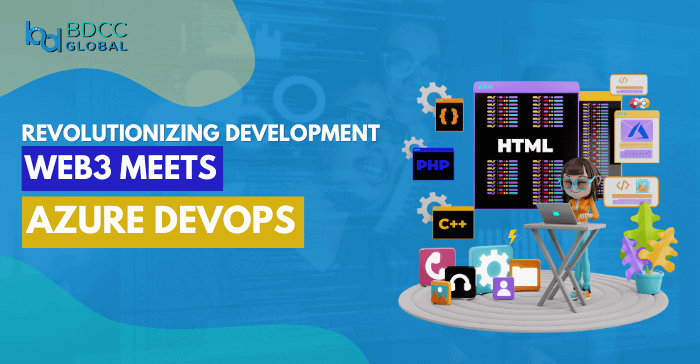
Do you know that Microsoft is experimenting with DLT Technologies like Web3 to integrate them with Azure DevOps? Microsoft plans to combine the power of decentralized applications (dApps) with the scalability and reliability of Azure cloud-based development.
“Embrace the synergy of Web3 and Azure DevOps, and witness the dawn of a new era in development.”
Previously, Web3 technology was the building block for popular ‘dApps.’ With their ability to make secure transactions, ‘dApps’ are still in high demand. That is why Microsoft aims to combine the capabilities of DevOps and Web3!
A Quick Intro to Web3
Web3 is a decentralized application platform that uses blockchain technologies to enable developers to build fully secured applications. No one has complete control over these applications. Unlike traditional centralized applications, Web3 applications allow users to control their application interactions. Besides, blockchain ensures application data is well-protected with increased control over the application users.
Why Integrate Web3 Technology With DevOps?
Microsoft Azure DevOps is a centralized cloud-based software development platform that offers a suite of tools to manage the entire SDLC. Developers can collaborate through the DevOps Portal to build, test, integrate, and deploy high-quality software.
Integrating Web3 technology with Azure DevOps Portal enables developers to leverage decentralized tools and technologies within a centralized development environment. It provides numerous benefits, including improved code security, enhanced team collaboration, and streamlined deployment processes.
Primary Steps To Integrate Web3 with MS DevOps
Step 1: Set The Development Environment
The first step is to set up a development environment in Microsoft Azure. This environment should include essential software development tools like Ganache or Truffle. These tools help in smart contracts testing and deployment on the Ethereum blockchain.
Step 2: Create a Project in DevOps Portal
Once the development environment is set, you can create a new Azure Project. This project will act as a centralized repository for the code. It includes various features like task management, source code management, bug tracking, continuous integration, and software deployment.
Step 3: Implement CI/CD Workflows
CI/CD is the latest SDLC practice that involves automatic code building, deploying, and testing. Developers of Azure Consulting Companies use CI/CD pipelines with Web3 tools to implement code changes sequentially. It ensures that their code is well-tested and up-to-date with blockchain technology standards.
Step 4: Use Smart Contracts for Automation
Smart Contracts are self-executing programs that are stored in a blockchain network. Web3 tools can execute Smart Contracts based on certain conditions automatically. They act as critical components of dApps, enforcing several development rules to automate complex SDLC workflows. By using web3 technologies and smart contracts in conjunction, DevOps developers can build dApps that are more transparent and secure.
Step 5: Leverage Web3 APIs
By leveraging Web3 APIs in AZ DevOps, developers can access blockchain networks and other DTC technologies. Developers can also integrate Web3 tools with the existing development workflows. It is more user-centric and scalable, helping developers improve the user experience (UX) of dApps.
Top Benefits Of Integration of Web3 Technologies with Azure DevOps
Integrating Web3 and DevOps brings the best capabilities of both platforms together. By leveraging the power of Web3, developers build transparent dApps even under a well-maintained blockchain network. Here are the top benefits of Web3 and DevOps integration:
Flexibility to Perform Decentralized Development
Alongside Web3 tools, developers use Azure container apps to deploy dApps securely. It gives more control over application interactions. So developers can take advantage of the scalability and reliability of cloud-based development while following the decentralization approach.
Increase the Security of The Applications
Web3 applications are inherently more secure than traditional centralized applications. Developers create Web3 apps resistant to cyber-attacks using Smart programs and Blockchain technology. It protects the applications from the ground up throughout the SDLC.
Maintain Design Transparency
DevOps companies ensure whichever Web3 application they build that are transparent by design. The main reason is to give users access to view all transactions and interactions on the blockchain network. It helps build trust between users and ensures everyone has fair and equitable access.
Simplify The Deployment Process
Azure Board, Azure Repos, Azure Artifacts, Azure Pipelines, and Azure Test Plans – Developers can use any available tools over the DevOps Portal. It simplifies the management process of the entire software development lifecycle.
So What’s Next for Blockchain with DevOps?
Azure DevOps is the latest invention from Microsoft to build and deploy Blockchain-ready applications. Integrating Web3 tech provides developers with suitable tools to develop decentralized apps. Plus, Azure adds its cloud-focused services to enhance the security of dApps. We have explored the primary steps involved in performing the integration. We have learned the immediate benefits of this solution. Indeed, Web3 tech and Microsoft’s DevOps integration offer a new paradigm for decentralized software development!
BDCC
Latest posts by BDCC (see all)
- Four Steps to Balance Agility and Security in DevSecOps - April 22, 2025
- Enhancing Security Posture with Azure’s AI-Driven Threat Detection - April 15, 2025
- Why Golang is Becoming the Go-To Language for DevOps Engineers - April 11, 2025

